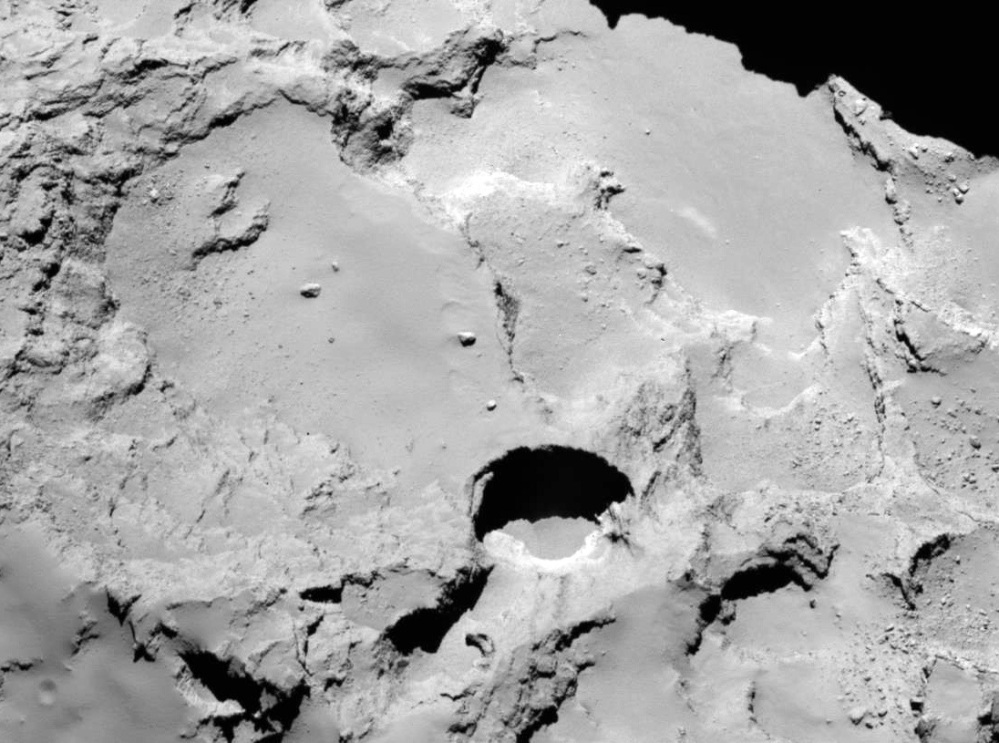Giant pits nearly 600 feet deep on the surface of Rosetta’s comet are likely caused by massive sinkholes, scientists say.
In a paper published in the journal Nature, researchers describe 18 mysterious depressions on the speeding comet that they say could only occur by sinkhole collapse.
On average, each of these quasi-circular holes are as wide as two football fields placed together, and some are as deep as the Washington monument is tall.
“That tells you something about the scale of these things,” said Dennis Bodewits of the University of Maryland and a co-investigator on Rosetta’s OSIRIS instrument. “They are really strange.”
The pits can be found clustered in just a few regions on the comet’s surface. There are small groups of them on both the “head” and “body” of the rubber-duck-shaped comet, but nearly all of them appear in the comet’s northern hemisphere.
Cameras on Rosetta’s OSIRIS instrument have spotted dust jets shooting out of some of the deeper depressions, but those that are more shallow do not seem to be active.
The authors explain that these large punctures could not have been made by impacts, because they have the wrong size distribution and you wouldn’t expect to see that many impact craters on a body as small as comet 67P.
They wondered if the pits might have formed as a result of the melting of frozen materials on the comet’s surface, also known as sublimation, but computer models nixed this idea as well.
The researchers say that excavating just one of the pits this way would take more than 7,000 years. Although the comet likely formed 4.5 billion years ago, it has only been flying close enough to the sun for sublimation to occur since 1959, when a close encounter with Jupiter changed its orbit.
The scientists also considered whether the pits were excavated by explosions on the surface of the nucleus. A big outburst was recorded on 67P in April 2014, and the comet grew brighter for a few days.
“We thought these pits had to be the source of the explosion, but when we did simulations, we found that just 100,000 kg of material had been ejected,” Bodewits said. “That sounds like a lot, but that would make a small hole of just a few meters, not a pit.”
It wasn’t until the team began to investigate the sinkhole hypothesis that they finally hit on a likely solution for the origin of the pits. It explains, for example, why they have near circular openings at the top and near vertical walls.
It might even explain the April outburst. A sinkhole collapse would expose material from beneath the surface of the comet for the first time, causing it to sublimate.
The researchers suggest that the sinkholes occur when a heat source inside the comet’s nucleus starts to turn surrounding ices into gas. The gas escapes or relocates, forming a cavity or a hole beneath the surface of the comet. Eventually the ceiling of this cavity becomes too thin to support its own weight. When it finally collapses, it will create a deep, circular pit with a smooth bottom.
But this solution leads to even more questions, including what is the interior heat source causing the subsurface sublimation? And why are the pits found only in certain regions of the comet? Is their structural makeup so different from other parts of the nucleus?
The researchers also say it is possible that these subsurface cavities have existed since the comet’s formation.
If the mission’s washing-machine-sized lander makes a full recovery, it is possible that it might provide some of the answers.
“We hope that Philae can use its radio instruments to probe the interior of the comet. Then we could see if we have these large cavities there or not,” said Bodewits, who was one of many authors on the Nature study.
In the meantime, he said that the pits have given scientists a thrilling opportunity to peer below the surface of the comet.
“We can really see the texture several hundred meters underneath the surface,” he said. “By themselves, they are giving us part of the story.”
Copy the Story Link
Send questions/comments to the editors.



Success. Please wait for the page to reload. If the page does not reload within 5 seconds, please refresh the page.
Enter your email and password to access comments.
Hi, to comment on stories you must . This profile is in addition to your subscription and website login.
Already have a commenting profile? .
Invalid username/password.
Please check your email to confirm and complete your registration.
Only subscribers are eligible to post comments. Please subscribe or login first for digital access. Here’s why.
Use the form below to reset your password. When you've submitted your account email, we will send an email with a reset code.